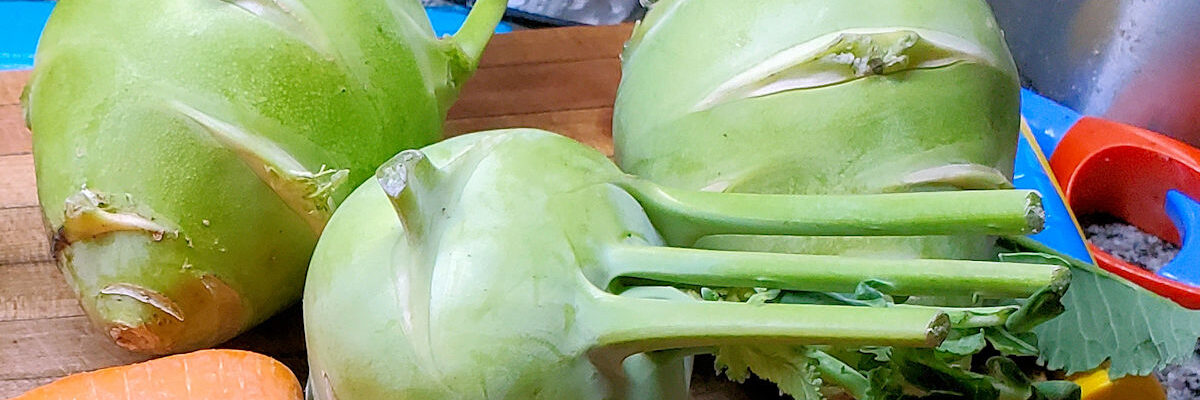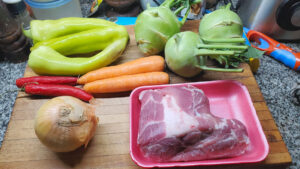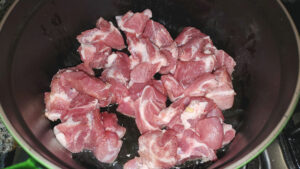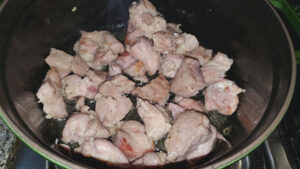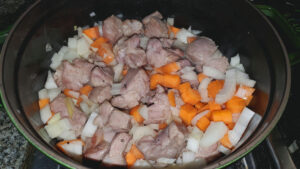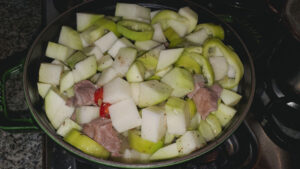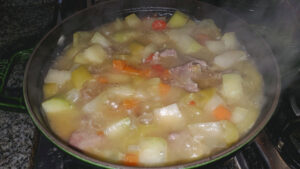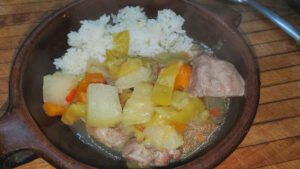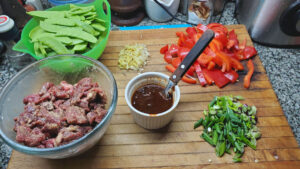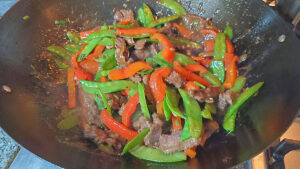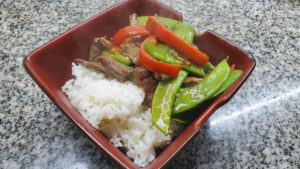A Kohlrabi, that’s what! A “German Turnip”, despite the fact that it’s neither German in origin, nor a turnip. It’s in the cabbage family, and it’s a fattened stalk of a plant that basically looks like, well, a big green turnip, and the name, I guess, is German, meaning “cabbage turnip”. Whatever! I put some in your stew, and you’re going to eat it and like it! I mentioned kohlrabi in my previous post, where I’d tried an excellent dish at MARTi restaurant of wood-fired oven roasted kohlrabi, and promised I’d share my recipe for a stew that uses the vegetable.
So here we have the kohlrabi on the upper right (and a zoom-in shot in the title photo above the post). Next to them, Italian frying peppers, some medium hot chilies, carrots, an onion, and pork shoulder. Salt, pepper, olive oil, and water not shown.
Cut the pork shoulder into roughly 1″ cubes and sauté them in olive oil with some salt and pepper…
…until lightly browned.
Add diced carrots and onions and cook until softened and the onions are starting to brown.
Add diced kohlrabi, and both the peppers and chilies in slices. Top with water not quite to cover – the kohlrabi release a lot of liquid – within minutes they’ll be submerged. Bring to a boil over medium hear, then cover the pot and cook for about half an hour over low heat. Remove the lid, and let it simmer away until the liquid evaporates and absorbs to the point where you’ve got a nice, stew-like texture, about another 15-20 minutes. This will also ensure the pork is nice and tender!
And there you have it. Adjust the seasoning with salt and pepper if needed. Because of the type of chilies I used, this is only moderately spicy. You can adjust that to your tastes with a spicier chili, or more of them, or less, or even none.
It’s fine served on its own, I like it with a bit of rice. Or mashed potatoes. Or polenta.
Can’t find kohlrabi anywhere? Try jicama, or daikon, or, hey, turnip! It’ll be different, but overall, much the same.
BONUS ROUND!
May as well throw in another dish with another vegetable that we don’t see here all that often, except, again, in Chinatown. The snap-pea, or snow-pea, or one of those. I’m not sure which of those these are. Are they different or the same? Enquiring minds want to know, but don’t feel like searching the internet to find out. They’re peas in a pod, but an edible pod, other than knicking off the point of it and pulling the fibrous string from the side.
Accompanying, some chopped ginger and garlic, a sliced red bell pepper, green onions, and… okay, the meat, thin sliced flank steak, coated with a mixture of salt, pepper, ground ginger, szechuan pepperorn, chili flakes, and cornstarch. The sauce a mix of oyster sauce, Chinese cooking wine, miso, sesame oil, rice wine vinegar, chili-bean paste, and brown sugar. More or less a tablespoon of each.
Get a wok or other similar pan really smoking hot. Add a few tablespoons of oil and sauté the beef rapidly until it’s just browned. Set it aside in a bowl, return the wok to the flame, add some more oil and sauté the ginger and garlic for about fifteen seconds, then add the peppers, thirty seconds, the snow peas, thirty seconds, the green onion, thirty seconds, return the beef to the pot, about another minute to cook through, and then add the sauce mixture and toss to coat well. The cornstarch on the beef and now stuck to the pan with thicken the sauce right up.
Serve up your “Szechuan style” beef and snow-peas with some rice and enjoy!
This dish is fairly spicy, with both the chili flakes on the beef and the chili-bean paste in the sauce. You can, again, make it more or less spicy to your tastes – add in some fresh chilies, or put a few drops of fiery chili oil into the sauce mix, or, use less or leave the chilies out. Then again, it wouldn’t really be “Szechuan style” anymore. It’d still be tasty.
